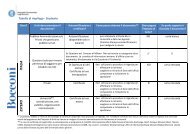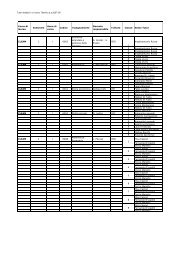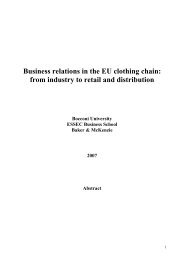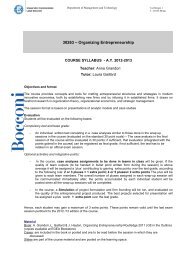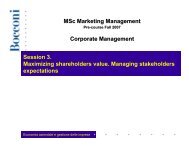Poetz and Schreier the value of crowdsourcing wp
Poetz and Schreier the value of crowdsourcing wp
Poetz and Schreier the value of crowdsourcing wp
Create successful ePaper yourself
Turn your PDF publications into a flip-book with our unique Google optimized e-Paper software.
literature might be <strong>the</strong> following: “relying on <strong>the</strong> method <strong>of</strong> asking buyers to describe<br />
potential future products, big leaps to novel product ideas are generally not likely” (Schulze<br />
<strong>and</strong> Hoegl 2008, p. 1744). In <strong>the</strong> experiment described above, <strong>the</strong> answer would be that <strong>the</strong><br />
company should ask its pr<strong>of</strong>essionals to generate new product ideas.<br />
On <strong>the</strong> o<strong>the</strong>r h<strong>and</strong>, however, <strong>the</strong>re is a second, alternative line <strong>of</strong> literature which posits that it<br />
is at least plausible that some users might have reasonably good new product ideas (Jeppesen<br />
<strong>and</strong> Frederiksen 2006). This idea is supported by a growing body <strong>of</strong> studies which – contrary<br />
to conventional wisdom – show that users <strong>of</strong>ten innovate for <strong>the</strong>mselves <strong>and</strong> that many <strong>of</strong><br />
those user innovations are characterized by high commercial attractiveness (von Hippel<br />
2005). Probably one <strong>of</strong> <strong>the</strong> most extreme <strong>and</strong> most frequently cited examples <strong>of</strong> user<br />
innovation is open source s<strong>of</strong>tware (such as Apache or Linux), which is developed<br />
exclusively by a community <strong>of</strong> users ra<strong>the</strong>r than pr<strong>of</strong>essional s<strong>of</strong>tware developers employed<br />
by firms (Bagozzi <strong>and</strong> Dholakia 2006, Lakhani <strong>and</strong> von Hippel 2003, Lerner <strong>and</strong> Tirole<br />
2002/2005, Pitt et al. 2006). 1 The great success <strong>of</strong> open source s<strong>of</strong>tware – Apache, for<br />
example, is outperforming Micros<strong>of</strong>t in terms <strong>of</strong> market share in <strong>the</strong> web server security<br />
s<strong>of</strong>tware market (see Netcraft.com) – has dramatically changed <strong>the</strong> potential role <strong>of</strong> users in<br />
corporate NPD efforts. In particular, a number <strong>of</strong> leading companies have already begun to<br />
experiment with <strong>the</strong> idea <strong>of</strong> harnessing <strong>the</strong> creative potential among users in order to fuel<br />
<strong>the</strong>ir own NPD pipelines.<br />
Analogous to open source s<strong>of</strong>tware, <strong>the</strong> underlying idea is to outsource <strong>the</strong> phase <strong>of</strong> idea<br />
generation to a potentially large <strong>and</strong> unknown population, referred to as <strong>the</strong> “crowd,“ in <strong>the</strong><br />
1 It should be noted, however, that pr<strong>of</strong>essional s<strong>of</strong>tware developers have also recently made major<br />
contributions to improving open source s<strong>of</strong>tware such as Apache or Linux on behalf <strong>of</strong> <strong>the</strong>ir<br />
employers (e.g., IBM). Because <strong>of</strong> <strong>the</strong> rapid diffusion <strong>of</strong> open source s<strong>of</strong>tware, firms have an interest<br />
in improving it even fur<strong>the</strong>r, for example in order to improve sales in complementary equipment (e.g.,<br />
server hardware or websphere s<strong>of</strong>tware).<br />
4



